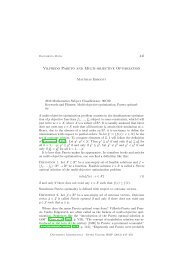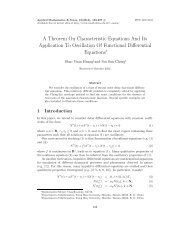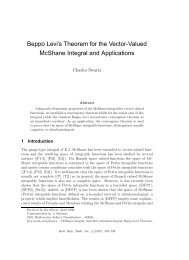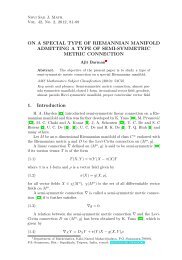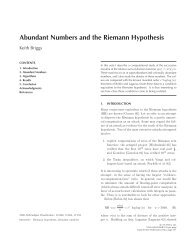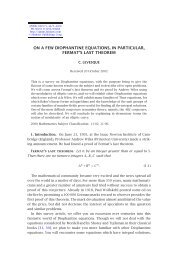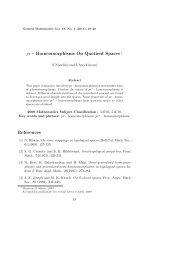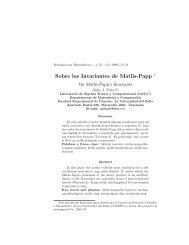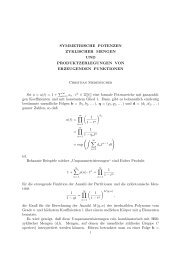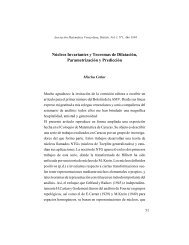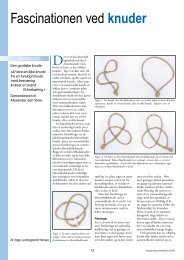REGULARIZATION AND HOLDER TYPE ERROR ESTIMATES FOR ...
REGULARIZATION AND HOLDER TYPE ERROR ESTIMATES FOR ...
REGULARIZATION AND HOLDER TYPE ERROR ESTIMATES FOR ...
You also want an ePaper? Increase the reach of your titles
YUMPU automatically turns print PDFs into web optimized ePapers that Google loves.
Acta Universitatis Apulensis<br />
ISSN: 1582-5329<br />
No. 30/2012<br />
pp. 314-333<br />
<strong>REGULARIZATION</strong> <strong>AND</strong> HÖLDER <strong>TYPE</strong> <strong>ERROR</strong> <strong>ESTIMATES</strong><br />
<strong>FOR</strong> AN INITIAL INVERSE HEAT PROBLEM WITH<br />
TIME-DEPENDENT COEFFICIENT<br />
Huy Tuan Nguyen, Phan Van Tri, Le Duc Thang, Nguyen Van Hieu<br />
Abstract. This paper discusses the initial inverse heat problem (backward<br />
heat problem) with time-dependent coefficient. The problem is ill-posed in the<br />
sense that the solution (if it exists) does not depend continuously on the data. Two<br />
regularization solutions of the backward heat problem will be given by a modified<br />
quasi-boundary value method. The Hölder type error estimates between the regularization<br />
solutions and the exact solution are obtained.<br />
Keywords and phrases: Backward heat problem, Ill-posed problem, Nonhomogeneous<br />
heat, Contraction principle.<br />
2000 Mathematics Subject Classification: 35K05, 35K99, 47J06, 47H10.<br />
1. Introduction<br />
In this paper, we consider the problem of finding the temperature u(x, t), (x, t) ∈<br />
(0, π) × [0, T ], such that<br />
⎧<br />
∂u<br />
⎪⎨ ∂t = b(t) ∂2 u, (x, t) ∈ (0, π) × (0, T )<br />
∂x 2<br />
u(0, t) = u(π, t) = 0, t ∈ (0, T )<br />
⎪⎩<br />
u(x, T ) = g(x), x ∈ (0, π)<br />
where b(t), g(x) are given. The problem is called the backward heat problem with<br />
time-dependent coefficient. It is well known that this is an ill-posed problem. The<br />
goal is to set up a regularization process that makes this problem well posed in the<br />
sense of Hadamard:<br />
(1) There is a solution.<br />
(2) The solution is unique.<br />
(3) The solution depends continuously on the data.<br />
(1)<br />
314
H.T. Nguyen, P.V. Tri, L.D. Thang, N.V. Hieu - Regularization and Hölder type...<br />
In the simple case b(t) = 1, the problem (1) is investigated in many papers,<br />
such as Clark and Oppenheimer [3], Denche and Bessila [4], Tautenhahn et al [21]<br />
Melnikova et al [11, 12], Trong et al [17, 18], B.Yildiz et al [22, 23].<br />
Although there are many papers on the backward heat equation with the constant<br />
coefficient, but there are rarely works considered the backward heat with the<br />
time-dependent coefficient, such as (1). A few works of analytical methods were<br />
presented for this problem, for example [14]. However, the authors in [14] only<br />
used numerical computation method and the stability theory with explicitly error<br />
estimate has not been generalized accordingly. In the present paper, we want to<br />
determine the temperature u(x, t) for 0 ≤ t < T by a modified quasi-boundary value<br />
method with two other approximation problems. Both methods of proving stability<br />
estimates are constructive: we construct stable solutions to the problem that can be<br />
numerically implemented. However, we do not pursue this aspect in this paper, as<br />
our aim here is to obtain stability estimates only. The numerical computation will<br />
be considered in our future research.<br />
This paper is organized as follows: In Section 2, we simply analyze the ill-posedness<br />
of the problem (1) and conditions (1), (2) of Hadamard are addressed in this section.<br />
In Sections 3 and 4, we introduce two regularization solutions and establish<br />
some error estimates between the exact solution and the regularization solutions,<br />
respectively.<br />
2.The ill-posedness of the backward heat problem<br />
We suppose that b(t) : [0, T ] → R is a continuous function on [0, T ] satisfying<br />
0 < B 1 ≤ b(t) ≤ B 2 , ∀t ∈ [0, T ]. Throughout this article, we denote by ‖.‖ the<br />
L 2 -norm and denote inner product on L 2 (0, π). We also suppose that f ∈<br />
L 2 ((0, T ); L 2 (0, π)) and g ∈ L 2 (0, π) .<br />
Let 0 = q < ∞. By H q (0, π) we denote the space of all functions g ∈ L 2 (0, π) with<br />
the property<br />
∞∑<br />
(1 + p 2 ) q |g p | 2 < ∞,<br />
p=1<br />
where g p = 2 ∫ π<br />
π 0 g(x) sin(px)dx. Then we also define ‖g‖2 H q (0,π) = ∑ ∞<br />
p=1 (1+p2 ) q |g p | 2 .<br />
If q = 0 then H q (0, π) is L 2 (0, π). In the following Theorem, we consider the existence<br />
condition of solution to the problem (1).<br />
Theorem 2.1. The problem (1) has a unique solution u if and only if<br />
∞∑<br />
p=1<br />
∫ T<br />
)<br />
exp<br />
(2p 2 b(s)ds gp 2 < ∞. (2)<br />
0<br />
315
H.T. Nguyen, P.V. Tri, L.D. Thang, N.V. Hieu - Regularization and Hölder type...<br />
Proof. Suppose the Problem (1) has an exact solution u ∈ C([0, T ]; H0 1 (0, π)) ∩<br />
C 1 ((0, T ); L 2 (0, π)), then u can be formulated in the frequency domain<br />
This implies that<br />
Therefore<br />
Then<br />
u(x, t) =<br />
∞∑<br />
p=1<br />
∫ T<br />
)<br />
exp<br />
(p 2 b(ξ)dξ gp 2 sin(px). (3)<br />
t<br />
u p (t) =< u(x, t), 2 π sin px >= exp (<br />
p 2 ∫ T<br />
‖u(., 0)‖ 2 = π 2<br />
t<br />
)<br />
b(ξ)dξ g p .<br />
∫ T<br />
)<br />
u p (0) = exp<br />
(p 2 b(s)ds g p . (4)<br />
0<br />
∞∑<br />
p=1<br />
If (2) holds, then define v(x) be as the function<br />
v(x) =<br />
∞∑<br />
p=1<br />
∫ T<br />
)<br />
exp<br />
(2p 2 b(s)ds gp 2 < ∞.<br />
0<br />
∫ T<br />
)<br />
exp<br />
(p 2 b(s)ds g p sin(px).<br />
0<br />
It is easy to see that v ∈ L 2 (0, π). Then, we consider the problem of finding u from<br />
the original value v<br />
⎧<br />
⎪⎨ u t − b(t)u xx = 0,<br />
u(0, t) = u(π, t) = 0, t ∈ (0, T )<br />
(5)<br />
⎪⎩<br />
u(x, 0) = v(x), x ∈ (0, π).<br />
The problem (5) is the direct problem so it has a unique solution u (See [5]). We<br />
have<br />
∞∑<br />
∫ t<br />
)<br />
u(x, t) =<br />
(exp{−p 2 b(ξ)dξ} < v(x), sin px > sin px.<br />
p=1<br />
0<br />
Thus<br />
u(x, T ) =<br />
∞∑<br />
∫ T<br />
(exp{−p 2<br />
p=1<br />
0<br />
)<br />
b(ξ)dξ} < v(x), sin px > sin px. (6)<br />
316
H.T. Nguyen, P.V. Tri, L.D. Thang, N.V. Hieu - Regularization and Hölder type...<br />
Therefore, we get<br />
∫ T<br />
)<br />
< v(x), sin px >= exp<br />
(p 2 b(s)ds g p . (7)<br />
0<br />
Since (6), (7) and by a simple computation, we get<br />
u(x, T ) =<br />
∞∑<br />
g p sin px = g(x).<br />
p=1<br />
Hence, u is the unique solution of (1).<br />
Theorem 2.2 The Problem (1) has at most one solution in C([0, T ]; H0 1 (0, π)) ∩<br />
C 1 ((0, T ); L 2 (0, π)). If (1) has a solution u then u is defined by<br />
u(x, t) =<br />
∞∑<br />
p=1<br />
∫ T<br />
)<br />
exp<br />
(p 2 b(ξ)dξ g p sin(px). (8)<br />
t<br />
Proof.<br />
The proof is divide into two step.<br />
Step 1. The Problem (1) has at most one solution.<br />
Let u(x, t), v(x, t) be two solutions of Problem (1) such that u, v ∈ C([0, T ]; H0 1 (0, π))∩<br />
C 1 ((0, T ); L 2 (0, π)). Put w(x, t) = u(x, t) − v(x, t). Then w satisfies the equation<br />
⎧<br />
⎪⎨ w t − b(t)w xx = 0,<br />
w(0, t) = w(π, t) = 0, t ∈ (0, T )<br />
⎪⎩<br />
w(x, 0) = 0, x ∈ (0, π).<br />
Now, setting G(t) = ∫ π<br />
0 w2 (x, t)dx<br />
G(t), we get<br />
(0 ≤ t ≤ T ), and by taking the derivative of<br />
∫ π<br />
∫ π<br />
G ′ (t) = 2 w(x, t)w t (x, t)dx = 2b(t) w(x, t)w xx (x, t)dx.<br />
0<br />
0<br />
Using Green formula, we obtain<br />
G ′ (t) = −2b(t)<br />
∫ π<br />
By taking the derivative of G ′ (t) in respect to t, one has<br />
G ′′ (t) = −4b(t)<br />
∫ π<br />
0<br />
0<br />
(9)<br />
w 2 x(x, t)dx. (10)<br />
w x (x, t)w xt (x, t)dx.<br />
317
H.T. Nguyen, P.V. Tri, L.D. Thang, N.V. Hieu - Regularization and Hölder type...<br />
By simple computation and using the integral in parts, we get<br />
G ′′ (t) = 4b(t)<br />
= 4b 2 (t)<br />
∫ π<br />
0<br />
∫ π<br />
0<br />
w xx (x, t)w t (x, t)dx<br />
Now, from (8) and applying the Holder inequality, we have<br />
∫ π<br />
Thus (7)-(8)-(9) imply<br />
0<br />
w 2 x(x, t)dx = −<br />
∫ π<br />
(∫ π<br />
≤ w 2 (x, t)dx<br />
0<br />
0<br />
w 2 x(x, t)dx. (11)<br />
w(x, t)w xx (x, t)dx<br />
) 1<br />
2 (∫ π<br />
(G ′ (t)) 2 ≤ G(t)G ′′ (t).<br />
0<br />
) 1<br />
wxx(x, 2 2<br />
t)dx . (12)<br />
Hence by the Theorem 11 [5], p.65, which gives G(t) = 0. This implies that u(x, t) =<br />
v(x, t). The proof is completed.<br />
Step 2. The Problem (1) has a solution which is defined in (8).<br />
To prove this, we only check that u satisfy three equations in system (1). By taking<br />
the derivative of u, we have<br />
∞∑<br />
∫ T<br />
)<br />
u t = −p 2 b(t) exp<br />
(p 2 b(ξ)dξ g p sin(px)<br />
p=1<br />
t<br />
∞∑<br />
= −p 2 b(t) < u(x, t), sin px > sin(px)<br />
p=1<br />
= b(t)u xx .<br />
In spite of the uniqueness, the problem (1) is still illposed and some regularization<br />
methods are necessary. In next Section, we introduce the approximation problem.<br />
3. Regularization by a mollification method<br />
In this section, we shall regularize the problem (1) by pertubing the final value<br />
g with a new way. Motivated by the idea of Clark and Oppenheimer [3], we approximate<br />
problem by the following problem<br />
⎧<br />
u ɛ t − b(t)u ɛ xx = 0, (x, t) ∈ (0, π) × (0, T ),<br />
⎪⎨<br />
u ɛ (0, t) = u ɛ (π, t) = 0, t ∈ (0, T )<br />
⎪⎩ u ɛ (x, T ) = ∑ ∞ exp{−p 2 ∫ T<br />
0 b(ξ)dξ}<br />
(13)<br />
p=1<br />
ɛp 2k + exp{−p ∫ 2 T<br />
0 b(ξ)dξ}g p sin(px), x ∈ (0, π).<br />
318
H.T. Nguyen, P.V. Tri, L.D. Thang, N.V. Hieu - Regularization and Hölder type...<br />
where 0 < ɛ < 1,<br />
f p (t) = 2 π<br />
∫ π<br />
0<br />
f(x, t) sin(px)dx,<br />
g p = 2 π<br />
∫ π<br />
0<br />
g(x) sin(px)dx<br />
and < ., . > is the inner product in L 2 ((0, π)). Note that if b(t) = 1 and k = 0 then<br />
the problem (1) has been considered in [3].<br />
We shall prove that, the (unique) solution u ɛ of (11) satisfies the following equality<br />
u ɛ (x, t) =<br />
∞∑<br />
p=1<br />
Lemma 3.1<br />
For M, ɛ, x > 0, k ≥ 1, we have the inequality<br />
exp{−p 2 ∫ t<br />
0 b(ξ)dξ}<br />
ɛp 2k + exp{−p 2 ∫ T<br />
0 b(ξ)dξ}g p sin(px). (14)<br />
(<br />
1<br />
ɛx k + e −Mx ≤ (kM)k ɛ −1 ln( M k ) −k<br />
kɛ ) .<br />
Proof.<br />
1<br />
Let the function f defined by f(x) = . By taking the derivative of f, one<br />
ɛx k +e −Mx<br />
has<br />
f ′ (x) = ɛkxk−1 − Me −Mx<br />
−(ɛx k + e −Mx ) 2 .<br />
The equation f ′ (x) = 0 gives a unique solution x 0 such that ɛkx0 k−1 − Me −Mx 0<br />
= 0.<br />
It means that x k−1<br />
0 e Mx 0<br />
= M kɛ<br />
. Thus the function f achieves its maximum at a<br />
unique point x = x 0 . Thus<br />
Since e −Mx 0<br />
= kɛ<br />
M xk−1 0 , one has<br />
1<br />
f(x) ≤<br />
ɛx k 0 + .<br />
e−Mx 0<br />
1<br />
f(x) ≤<br />
ɛx k 0 + ≤<br />
e−Mx 0<br />
By using the inequality e Mx 0<br />
≥ Mx 0 , we get<br />
M<br />
kɛ<br />
= x k−1<br />
0 e Mx 0<br />
≤<br />
=<br />
1<br />
ɛx k 0 + kɛ .<br />
M xk−1 0<br />
1<br />
M k−1 e(k−1)Mx 0<br />
e Mx 0<br />
1<br />
M k−1 ekMx 0<br />
.<br />
319
H.T. Nguyen, P.V. Tri, L.D. Thang, N.V. Hieu - Regularization and Hölder type...<br />
This gives e kMx 0<br />
≥ M k<br />
kɛ<br />
Hence, we obtain<br />
or kMx 0 ≥ ln( M k<br />
kɛ<br />
). Therefore<br />
x 0 ≥ 1<br />
kM ln(Mk kɛ ).<br />
f(x) ≤ 1<br />
ɛx k 0<br />
≤<br />
(kM)k<br />
ɛ ln k ( M k<br />
kɛ ).<br />
Lemma 3.2<br />
For 0 ≤ m ≤ M, we have the following inequality<br />
e −mx<br />
(<br />
ɛx k + e −Mx ≤ (kM)k ɛ m M −1 ln( M k ) k(<br />
m<br />
kɛ ) M −1) .<br />
Proof.<br />
Since the inequality<br />
1<br />
ɛx k +e −Mx ≤ (kM) k ɛ −1 (<br />
ln( M k<br />
kɛ ) ) −k,<br />
we obtain<br />
e −mx<br />
ɛx k + e −Mx =<br />
≤<br />
≤<br />
e −mx<br />
(ɛx k + e −Mx ) m M (ɛx k + e −Mx ) 1− m M<br />
1<br />
(ɛx k + e −Mx ) 1− m M<br />
(<br />
[(kM) k ɛ −1 ln( M k ) −k<br />
] 1−<br />
m<br />
M<br />
kɛ )<br />
(<br />
≤ (kM) k(1− m M ) ɛ m M −1 ln( M k ) k(<br />
m<br />
kɛ ) M −1)<br />
≤ (kM) k ɛ m M −1 (<br />
ln( M k<br />
kɛ ) ) k(<br />
m<br />
M −1) .<br />
In next Theorem, we shall study the existence, the uniqueness and the stability of<br />
a (weak) solution of Problem (6)-(8). In fact, one has<br />
Theorem 3.1 The problem (11) has uniquely a weak solution u ɛ ∈ satisfying (10).<br />
The solution depends continuously on g in L 2 (0, π)).<br />
Proof<br />
The proof is divided into two steps. In Step 1, we prove the existence and the<br />
uniqueness of a solution of (6)-(8). In Step 2, the stability of the solution is given.<br />
Denote W = ([0, T ]; L 2 (0, π) ∩ L 2 (0, T ; H0 1(0, π)) ∩ C1 (0, T ; H0 1 (0, π)).<br />
Step 1. The existence and the uniqueness of a solution of (6)-(8)<br />
320
H.T. Nguyen, P.V. Tri, L.D. Thang, N.V. Hieu - Regularization and Hölder type...<br />
We divide this step into two parts.<br />
Part A If u ɛ ∈ W satisfies (11) then u ɛ is solution of (6)-(8).<br />
We have:<br />
u ɛ (x, t) =<br />
∞∑<br />
p=1<br />
We can verify directly that u ɛ ∈ W . Moreover, one has<br />
This implies that<br />
exp{−p 2 ∫ t<br />
0 b(ξ)dξ}<br />
ɛp 2k + exp{−p 2 ∫ T<br />
0 b(ξ)dξ}g p sin(px). (15)<br />
< u ɛ t(x, t), sin(px) > = −p2 b(t) exp{−p 2 ∫ t<br />
0 b(ξ)dξ}<br />
ɛp 2k + exp{−p ∫ 2 T<br />
0 b(ξ)dξ} g p<br />
u ɛ (x, T ) =<br />
∞∑<br />
p=1<br />
= −p 2 b(t) < u ɛ (x, t), sin px ><br />
= b(t) < u ɛ xx(x, t), sin(px).<br />
u ɛ t = b(t)u ɛ xx<br />
exp{−p 2 ∫ T<br />
0 b(ξ)dξ}<br />
ɛp 2k + exp{−p 2 ∫ T<br />
0 b(ξ)dξ}g p sin(px).<br />
So u ɛ is the solution of (6)−(8).<br />
Part B. The Problem (6)-(8) has at most one solution C([0, T ]; H0 1 (0, π)) ∩<br />
C 1 ((0, T ); L 2 (0, π)).<br />
Proof.<br />
We can prove this Theorem by similar way in Step 1 of Theorem 2.2.<br />
Since Part A and Part B, we complete the proof of Step 1.<br />
Step 2. The solution of the problem (6)−(8) depends continuously on g in L 2 (0, π).<br />
Let u and v be two solutions of (6) − (8) corresponding to the final values g and h.<br />
From we have<br />
∞∑ exp{−p 2 ∫ t<br />
0<br />
u(x, t) =<br />
b(ξ)dξ}<br />
p=1 ɛp 2k + exp{−p ∫ 2 T<br />
0 b(ξ)dξ}g p sin(px). (16)<br />
where<br />
v(x, t) =<br />
∞∑<br />
p=1<br />
exp{−p 2 ∫ t<br />
0 b(ξ)dξ}<br />
ɛp 2k + exp{−p 2 ∫ T<br />
0 b(ξ)dξ}h p sin(px), (17)<br />
g p = 2 π<br />
h p = 2 π<br />
∫ π<br />
0<br />
∫ π<br />
0<br />
g(x) sin(px)dx,<br />
h(x) sin(px)dx.<br />
321
H.T. Nguyen, P.V. Tri, L.D. Thang, N.V. Hieu - Regularization and Hölder type...<br />
This follows that<br />
u(., t) − v(., t) 2 = π 2<br />
where<br />
Hence<br />
≤ π 2<br />
≤ π 2<br />
∞∑<br />
exp{−p 2 ∫ t<br />
0 b(ξ)dξ}<br />
∣ɛp 2k + exp{−p ∫ 2 T<br />
0 b(ξ)dξ}(g p − h p )<br />
∣<br />
∞∑<br />
exp{−B 1 tp 2 2<br />
}<br />
∣ɛp 2k + exp{−B 2 T p 2 } (g p − h p )<br />
∣ ,<br />
p=1<br />
p=1<br />
⎛<br />
(<br />
⎝(kB 2 T ) k ɛ B 1 t<br />
B 2 T −1 ln( (B 2T ) k<br />
)<br />
kɛ<br />
2<br />
) B k( 1 t<br />
−1)⎞ B 2 T<br />
∑ ∞<br />
⎠2<br />
,<br />
p=1<br />
|g p − h p | 2<br />
= B4ɛ 2 2B 1 t<br />
B 2 T<br />
(ln( −2 B ) B −2k(1− 1 t<br />
3<br />
ɛ ) B 2 T ) ‖g − h‖ 2 . (18)<br />
B 3 = (B 2T ) k<br />
, (19)<br />
k<br />
B 4 = (kB 2 T ) k . (20)<br />
u(., t) − v(., t) ≤ B 4 ɛ B 1 t<br />
B 2 T<br />
(ln( −1 B ) B −k(1− 1 t<br />
3<br />
ɛ ) B 2 T ) g − h.<br />
This completes the proof of Step 2 and the proof of our theorem.<br />
Theorem 3.2 Let g(x) ∈ L 2 (0, π) be the function satisfies the following condition<br />
∞∑<br />
p 4k e 2T B 2p 2 gp 2 < ∞,<br />
p=1<br />
where g p = 2 ∫ π<br />
π 0 g(x) sin(px)dx. Then uɛ (x, T ) converges to g(x) in L 2 (0, π) with<br />
order ( ln( B 3<br />
ɛ<br />
) ) −k<br />
as ɛ tends to zero.<br />
Proof.<br />
We have g(x) = ∞ ∑<br />
p=1<br />
g p sin(px), where g p is defined in (9). Let α > 0. Then there<br />
exists a positive integer number N for which π 2<br />
‖u ɛ (x, T ) − g(x)‖ 2 = π 2<br />
p=1<br />
∞∑<br />
p=N+1<br />
g 2 p < α/2. We have<br />
∞∑<br />
ɛ 2 p 4k gp<br />
2<br />
(<br />
ɛp 2k + exp{−p ∫ ) 2 T<br />
2<br />
. (21)<br />
0 b(ξ)dξ}<br />
322
H.T. Nguyen, P.V. Tri, L.D. Thang, N.V. Hieu - Regularization and Hölder type...<br />
Then since<br />
(ɛp 2k + exp{−p 2 ∫ T<br />
we get<br />
By taking ɛ such that ɛ < √ α<br />
We end the proof.<br />
By using the inequality<br />
0<br />
) ∫ 2 T<br />
b(ξ)dξ} > ɛ 2 p 4k + exp{−2p 2 b(ξ)dξ}<br />
0<br />
> ɛ 2 p 4k + e −2T B 2p 2<br />
‖u ɛ (x, T ) − g(x)‖ 2 ≤ ɛ 2 π 2<br />
> e −2T B 2p 2 ,<br />
N∑<br />
p 4k gpe 2 2T B 2p 2 + α 2 .<br />
p=1<br />
(<br />
) −1<br />
∑<br />
π N 2<br />
p 4k gpe 2 2T B 2p 2 , we get<br />
p=1<br />
‖u ɛ (x, T ) − g(x)‖ 2 < α.<br />
(<br />
1<br />
ɛx k + e −B ≤ (kT B<br />
2T x 2 ) k ɛ −1<br />
ln( (B 2T ) k<br />
kɛ<br />
(<br />
= B 4 ɛ −1 ln( (B ) −k<br />
3)<br />
)<br />
ɛ<br />
) −k<br />
)<br />
we have the error estimate<br />
‖u ɛ (x, T ) − g(x)‖ 2 = π ∞∑<br />
ɛ 2 p 4k gp<br />
2<br />
(<br />
2<br />
p=1 ɛp 2k + exp{−p ∫ ) 2 T<br />
2<br />
0 b(ξ)dξ}<br />
≤ π ∞∑ ɛ 2 p 4k gp<br />
2 (<br />
2<br />
p=1 ɛp 2k + e −T B 2p 2) 2<br />
≤ π (<br />
2 ɛ2 B4ɛ 2 −2 ln( (B ) −2k<br />
3) ∑ ∞<br />
) p 4k gp<br />
2 ɛ<br />
p=1<br />
(<br />
= B4<br />
2 ln( B ) −2k<br />
3<br />
ɛ ) π<br />
∞∑<br />
p 4k g 2<br />
2<br />
p.<br />
This implies that<br />
√<br />
(<br />
‖u ɛ (x, T ) − g(x)‖ ≤ B 4 ln( B ) −k √√√<br />
3<br />
ɛ ) π<br />
2<br />
323<br />
p=1<br />
∞∑<br />
p 4k gp.<br />
2<br />
p=1
H.T. Nguyen, P.V. Tri, L.D. Thang, N.V. Hieu - Regularization and Hölder type...<br />
This ends the proof.<br />
Theorem 3.3<br />
Let g ∈ L 2 (0, π) be as Theorem 3.2. If u ɛ (x, 0) converges in L 2 (0, π), then the problem<br />
(1)-(3) has a unique solution u. Furthermore, the regularized solution u ɛ (x, t)<br />
converges to u(t) as ɛ tends to zero uniformly in t.<br />
Proof. Assume that lim u ɛ (x, 0) = u 0 (x) exists. Let<br />
ɛ→0<br />
u(x, t) =<br />
∞∑<br />
∫ t<br />
exp{−p 2 b(ξ)dξ}u 0p sin(px)<br />
p=1<br />
where u 0p = 2 ∫ π<br />
π 0 u 0(x) sin(px)dx.<br />
It is clear to see that u(x, t) satisfies (1)-(2). We have the formula of u ɛ (x, t)<br />
u ɛ (x, t) =<br />
0<br />
∞∑<br />
∫ t<br />
exp{−p 2 b(ξ)dξ}u ɛ 0p sin(px)<br />
p=1<br />
where u ɛ 0p = 2 ∫ π<br />
π 0 uɛ (x, 0) sin(px)dx.<br />
We have in view of the inequality (a + b) 2 ≤ 2(a 2 + b 2 )<br />
‖u ɛ (., t) − u(., t)‖ 2 ≤ π 2<br />
∞∑<br />
p=1<br />
0<br />
∫ t<br />
)<br />
exp<br />
(−2p 2 b(s)ds (u ɛ 0p − u 0p ) 2<br />
0<br />
≤ ‖u ɛ (., 0) − u 0 (.)‖ 2 .<br />
Hence lim u ɛ (x, t) = u(x, t). Thus lim u ɛ (x, T ) = u(x, T ). Using the theorem 2.2,<br />
ɛ→0 ɛ→0<br />
we have u(x, T ) = g(x). Hence, u(x, t) is the unique solution of the problem (1)-(3).<br />
We also see that u ɛ (x, t) converges to u(x, t) uniformly in t.<br />
Theorem 3.4<br />
Let f ∈ L 2 (0, T ; L 2 (0, π)) and g ∈ L 2 (0, π) . Suppose Problem (1)-(3) has a<br />
unique solution u(x, t) in C([0, T ]; H0 1(0, π)) ∩ C1 ((0, T ); L 2 (0, π)) which satisfies<br />
∞∑<br />
p 4k u 2 p(t) < ∞. Then<br />
p=1<br />
u(., t) − u ɛ (., t) ≤ C<br />
for every t ∈ [0, T ], where C = B 4<br />
√<br />
π<br />
2 sup<br />
∞∑<br />
p 4k u 2 p(t) and u ɛ is the unique solution<br />
of Problem (6)-(8).<br />
(<br />
ln( B 3<br />
ɛ ) ) −k<br />
t∈[0,T ] p=1<br />
324
H.T. Nguyen, P.V. Tri, L.D. Thang, N.V. Hieu - Regularization and Hölder type...<br />
Proof<br />
Suppose the Problem (1)-(3) has an exact solution u ∈ C([0, T ]; H 1 0 (0, π))∩C1 ((0, T ); L 2 (0, π)),<br />
we get the following formula<br />
u(x, t) =<br />
Since (10) and (20), we get<br />
∞∑<br />
p=1<br />
[ ∫ T<br />
) ]<br />
exp<br />
(p 2 b(ξ)dξ g p sin(px). (22)<br />
t<br />
=<br />
=<br />
≤<br />
≤<br />
|u p (t) − u ɛ p(t)| =<br />
[<br />
∫ T<br />
)<br />
exp<br />
(p 2 exp{−p 2 ∫ ]∣<br />
t<br />
0<br />
b(ξ)dξ −<br />
b(ξ)dξ} ∣∣∣∣<br />
∣<br />
t<br />
ɛp 2k + exp{−p ∫ 2 T<br />
0 b(ξ)dξ} g p<br />
(<br />
exp p 2 ∫ ) ∣<br />
T<br />
∣ ɛp2k<br />
t<br />
b(ξ)dξ ∣∣∣∣∣<br />
ɛp 2k + exp{−p ∫ 2 T<br />
0 b(ξ)dξ} g p<br />
∣ ∫<br />
1<br />
∣∣∣ T<br />
) ∣ ∣∣∣<br />
ɛ<br />
ɛp 2k + exp{−p ∫ 2 T<br />
0 b(ξ)dξ} p 2k exp<br />
(p 2 b(ξ)dξ g p<br />
t<br />
∣ ∫<br />
ɛ ∣∣∣ T<br />
) ∣ ∣∣∣<br />
ɛp 2k + e −B p 2k exp<br />
(p 2 b(ξ)dξ g<br />
2T p 2 p .<br />
t<br />
This follows that<br />
Hence<br />
u(., t) − u ɛ (., t) 2 = π ∞∑<br />
|u p (t) − u ɛ<br />
2<br />
p(t)| 2<br />
p=1<br />
≤ π (<br />
2 B2 4 ln( B ) −2k ∞<br />
3<br />
ɛ ) ∑<br />
p 4k u 2 p(t)<br />
≤ C 2 (<br />
ln( B 3<br />
ɛ ) ) −2k<br />
.<br />
u(., t) − u ɛ (., t) ≤ C<br />
p=1<br />
(<br />
ln( B 3<br />
ɛ ) ) −k<br />
where C = B 4<br />
√<br />
π<br />
2 sup<br />
t∈[0,T ] p=1<br />
∞∑<br />
p 4k u 2 p(t).<br />
This completes the proof of Theorem.<br />
325
H.T. Nguyen, P.V. Tri, L.D. Thang, N.V. Hieu - Regularization and Hölder type...<br />
Theorem 3.5 Let f, g, ɛ be as in Theorem 3.4. Assume that the exact solution u of<br />
∑<br />
(1)−(3) corresponding to g satisfies u ∈ W and ∞ p 4k u 2 p(t) < ∞. Let g ɛ ∈ L 2 (0, π)<br />
be a measured data such that g ɛ − g ≤ ɛ. Then there exists a function v ɛ satisfying<br />
⎡<br />
⎤<br />
(<br />
u(., t) − v ɛ (., t) ≤ ⎣C + ɛ ln k ( B ) B 1 t (<br />
3<br />
ɛ ) B 2 T<br />
⎦ ln( B ) −k<br />
3<br />
ɛ )<br />
for every t ∈ [0, T ] and C is defined in theorem 3.4.<br />
Proof<br />
Let u ɛ be the solution of problem (6)-(8) corresponding to g and let v ɛ be the<br />
solution of problem (6)-(8) corresponding to g ɛ where g, g ɛ are in right hand side of<br />
(6). Using Theorem 3.4 and Step 2 of theorem 3.1, we get<br />
p=1<br />
v ɛ (., t) − u(., t) ≤ v ɛ (., t) − u ɛ (., t) + u ɛ (., t) − u(., t)<br />
≤<br />
≤<br />
ɛ B 1 t<br />
B 2 T<br />
(ln( −1 B ) B −k(1− 1 t<br />
3<br />
ɛ )<br />
(<br />
ln( B 3<br />
ɛ ) ) −k<br />
⎡<br />
⎣C +<br />
B 2 T ) g ɛ − g + C<br />
⎤<br />
(<br />
ɛ ln k ( B ) B 1 t<br />
3<br />
ɛ ) B 2 T<br />
⎦<br />
for every t ∈ (0, T ) and where C is defined in Theorem 3.4<br />
This completed the proof of Theorem.<br />
4. Improved estimates with Hölder type<br />
(<br />
ln( B 3<br />
ɛ ) ) −k<br />
∑<br />
In Section 3, Theorem 3.4, with the condition ∞ p 4k u 2 p(t) < ∞, we establish<br />
the error between the exact solution and regularized solution which is of logarithmic<br />
order. The convergence rates here are very slow. To get a stability estimate of<br />
Hölder type for the whole [0; T ], we introduce a new regularized problem, which is<br />
given by<br />
⎧<br />
u ɛ t − b(t)u ɛ xx = 0, (x, t) ∈ (0, π) × (0, T )<br />
⎪⎨<br />
u ɛ (0, t) = u ɛ (π, t) = 0, t ∈ (0, T )<br />
⎪⎩<br />
u ɛ (x, T ) = ∑ ∞ exp{−p 2 ∫ T<br />
0 b(ξ)dξ − mp2 }<br />
p=1<br />
ɛp 2k + exp{−p ∫ 2 T<br />
0 b(ξ)dξ − mp2 } g p sin(px), x ∈ (0, π)<br />
where m ≥ 0 is a fixed number and 0 < ɛ < 1. If m = 0 then the problem (23) is<br />
also the problem (13) which introduced in Section 3. The (unique) solution u ɛ of<br />
326<br />
p=1<br />
(23)
H.T. Nguyen, P.V. Tri, L.D. Thang, N.V. Hieu - Regularization and Hölder type...<br />
(23) satisfies the following equality<br />
u ɛ (x, t) =<br />
∞∑<br />
p=1<br />
exp{−p 2 ∫ t<br />
0 b(ξ)dξ − mp2 }<br />
ɛp 2k + exp{−p 2 ∫ T<br />
0 b(ξ)dξ − mp2 } g p sin(px), 0 ≤ t ≤ T. (24)<br />
Let v ɛ be the solution of (23) corresponding to the measured data g ɛ . Then we also<br />
have<br />
∞∑<br />
v ɛ exp{−p 2 ∫ t<br />
0<br />
(x, t) =<br />
b(ξ)dξ − mp2 }<br />
p=1 ɛp 2k + exp{−p ∫ 2 T<br />
0 b(ξ)dξ − mp2 } gɛ p sin(px), 0 ≤ t ≤ T. (25)<br />
where gp ɛ = 2 ∫ π<br />
π 0 gɛ (x) sin pxdx. The main purpose of this section is of considering<br />
the error ‖v ɛ (., t) − u(., t)‖.<br />
We have the following theorem<br />
Theorem 4.1<br />
Let f ∈ L 2 (0, T ; L 2 (0, π)) and g ∈ L 2 (0, π). Suppose Problem (1)-(3) has a unique<br />
solution u(x, t) in C([0, T ]; H0 1(0, π)) ∩ C1 ((0, T ); L 2 (0, π)) which satisfies<br />
where u p (0) = 2 π<br />
∫ π<br />
0<br />
∞∑<br />
p 4k e 2mp2 u 2 p(0) < ∞, (26)<br />
p=1<br />
u(x, 0) sin pxdx. Then the following estimate is holds<br />
( )<br />
(<br />
) B<br />
u(., t) − v ɛ (., t) ≤ E(m, k)ɛ B 1 t+m D(m, k) k 1 t+m<br />
B 2 T +m −1<br />
B 2 T +m<br />
ln( )<br />
. (27)<br />
ɛ<br />
for every t ∈ [0, T ], where<br />
C(m, k) = (kB 2 T + km) k<br />
D(m, k) = (B 2T + m) k<br />
k<br />
( √ √√ ∑<br />
∞ )<br />
E(m, k) = C(m, k) p 4k e 2mp2 u 2 p(0) + 1 .<br />
p=1<br />
Remark.<br />
1. If m = 0, then error u(., t) − v ɛ (., t) is of order<br />
( )<br />
( ) B<br />
ɛ B 1 t D(0, k) k 1 t<br />
B 2 T −1<br />
B 2 T<br />
ln( )<br />
.<br />
ɛ<br />
327
H.T. Nguyen, P.V. Tri, L.D. Thang, N.V. Hieu - Regularization and Hölder type...<br />
Let t = 0 then u(., 0) − v ɛ (., 0) is of order<br />
as one in Theorem 3.4.<br />
2.The error (27) is of order ɛ<br />
m<br />
B 2 T +m<br />
(<br />
ln( D(m,k)<br />
m<br />
(<br />
ln( D(0,k)<br />
ɛ<br />
)) −k,<br />
which is the same order<br />
ɛ<br />
)<br />
) k<br />
(<br />
)<br />
m<br />
B 2 T +m −1<br />
for all t ∈ [0, T ]. As<br />
we know, the convergence rate of ɛ<br />
B 2 T +m<br />
( )<br />
is faster than that of the logarithmic order<br />
( ) k<br />
ln( D(m,k)<br />
m<br />
B<br />
ɛ<br />
) 2 T +m −1 which is introduced in Section 3. To our knowledge, this<br />
seems to be the optimal error order for backward heat. This is a strong point of this<br />
method.<br />
Proof.<br />
Step 1. We estimate ‖u ɛ (., t) − u(., t)‖. We have<br />
u p (t) − u ɛ p(t) =<br />
[ ∫ T<br />
)<br />
= exp<br />
(p 2 exp{−p 2 ∫ t<br />
0<br />
b(ξ)dξ −<br />
b(ξ)dξ − ]<br />
mp2 }<br />
t<br />
ɛp 2k + exp{−p ∫ 2 T<br />
0 b(ξ)dξ − g p<br />
mp2 }<br />
(<br />
exp p 2 ∫ )<br />
T<br />
= ɛp 2k t<br />
b(ξ)dξ<br />
ɛp 2k + exp{−p ∫ 2 T<br />
0 b(ξ)dξ − mp2 } g p<br />
(<br />
exp p 2 ∫ )<br />
T<br />
= ɛp 2k t<br />
b(ξ)dξ<br />
ɛp 2k + exp{−p ∫ 2 T<br />
0 b(ξ)dξ − mp2 } g p. (28)<br />
√<br />
(<br />
2<br />
Since < u(x, t),<br />
π sin px >= exp p 2 ∫ )<br />
T<br />
t<br />
b(ξ)dξ g p , we get<br />
Or<br />
u p (0) = 2 π < u(x, 0), sin px >= exp (<br />
p 2 ∫ T<br />
0<br />
)<br />
b(ξ)dξ g p ,<br />
∫ T<br />
)<br />
g p = exp<br />
(−p 2 b(ξ)dξ u p (0). (29)<br />
0<br />
Combining (28) and (29), we obtain<br />
(<br />
exp −p 2 ∫ )<br />
t<br />
u p (t) − u ɛ p(t) = ɛp 2k 0 b(ξ)dξ<br />
ɛp 2k + exp{−p ∫ 2 T<br />
0 b(ξ)dξ − mp2 } u p(0)<br />
(<br />
exp −p 2 ∫ )<br />
t<br />
= ɛp 2k 0 b(ξ)dξ − mp2<br />
ɛp 2k + exp{−p ∫ 2 T<br />
0 b(ξ)dξ − mp2 } exp ( mp 2) u p (0). (30)<br />
328
H.T. Nguyen, P.V. Tri, L.D. Thang, N.V. Hieu - Regularization and Hölder type...<br />
On the other hand, we note that<br />
(<br />
exp −p 2 ∫ )<br />
t<br />
0 b(ξ)dξ − mp2<br />
ɛp 2k + exp{−p 2 ∫ T<br />
0 b(ξ)dξ − mp2 }<br />
For a short, we denote<br />
≤<br />
≤<br />
e −(B 1t+m)p 2<br />
ɛp 2k + e −(B 2T +m)p 2<br />
(<br />
(kB 2 T + km) k ɛ B 1 t+m<br />
B 2 T +m −1 ln( (B 2T + m) k<br />
)<br />
kɛ<br />
) k(<br />
B 1 t+m<br />
B 2 T +m −1) (31).<br />
Then (31) can be rewritten as follows<br />
C(m, k) = (kB 2 T + km) k<br />
D(m, k) = (B 2T + m) k<br />
.<br />
k<br />
(<br />
exp −p 2 ∫ )<br />
t<br />
0 b(ξ)dξ − mp2<br />
ɛp 2k + exp{−p ∫ 2 T<br />
0 b(ξ)dξ − mp2 } ≤ C(m, k)ɛ B 1 t+m<br />
It follows from (30) and (32), we get<br />
‖u(., t) − u ɛ (., t)‖ 2<br />
∞∑<br />
= |u p (t) − u ɛ p(t)| 2<br />
p=1<br />
Therefore<br />
≤ ɛ 2 C 2 (m, k)ɛ 2 B 1 t+m<br />
B 2 T +m −2 (<br />
ln(<br />
(<br />
≤ C 2 (m, k)ɛ 2 B 1 t+m<br />
B 2 T +m<br />
ln(<br />
B 2 T +m −1 (<br />
ln(<br />
( )<br />
) B<br />
D(m, k) 2k 1 t+m<br />
B 2 T +m −1<br />
)<br />
ɛ<br />
( )<br />
) B<br />
D(m, k) 2k 1 t+m<br />
B 2 T +m −1<br />
)<br />
ɛ<br />
( )<br />
) B<br />
D(m, k) k 1 t+m<br />
B 2 T +m −1<br />
)<br />
. (32)<br />
ɛ<br />
∞∑<br />
p 4k exp ( 2mp 2) u 2 p(0)<br />
p=1<br />
∞∑<br />
p 4k e 2mp2 u 2 p(0).<br />
‖u(., t) − u ɛ (., t)‖<br />
( )<br />
(<br />
) B<br />
≤ C(m, k)ɛ B 1 t+m D(m, k) k 1 t+m √√√√<br />
B 2 T +B 2 m −1 ∑<br />
∞<br />
B 2 T +m<br />
ln( )<br />
p<br />
ɛ<br />
4k e 2mp2 u 2 p(0). (33)<br />
p=1<br />
p=1<br />
329
H.T. Nguyen, P.V. Tri, L.D. Thang, N.V. Hieu - Regularization and Hölder type...<br />
Step 2. We estimate the term ‖v ɛ (., t) − u ɛ (., t)‖. Indeed, we have<br />
‖v ɛ (., t) − u ɛ (., t)‖ 2 =<br />
≤<br />
∞∑ ( exp{−p 2 ∫ t<br />
0 b(ξ)dξ − mp2 } ) 2 ) 2 (g<br />
ɛp 2k + exp{−p ∫ ɛ 2 T<br />
0 b(ξ)dξ − mp2 p − g p<br />
}<br />
∞∑ (<br />
e −(B 1t+m)p 2 ) 2 ( ) 2.<br />
ɛp 2k + e −(B g ɛ 2T +m)p 2 p − g p<br />
p=1<br />
p=1<br />
Using (32) we obtain<br />
≤<br />
≤<br />
≤<br />
‖v ɛ (., t) − u ɛ (., t)‖ 2<br />
( )<br />
(<br />
) B<br />
C 2 (m, k)ɛ 2 B 1 t+m<br />
B 2 T +m −2 D(m, k) 2k 1 t+m<br />
B 2 T +m −1<br />
ln( )<br />
ɛ<br />
p=1<br />
( )<br />
(<br />
) B<br />
C 2 (m, k)ɛ 2 B 1 t+m<br />
B 2 T +m −2 D(m, k) 2k 1 t+m<br />
B 2 T +m −1<br />
ln( )<br />
‖g ɛ − g‖ 2<br />
ɛ<br />
C 2 (m, k)ɛ 2 B 1 t+m<br />
B 2 T +m −2 (<br />
ln(<br />
= C 2 (m, k)ɛ 2B 1 t+2m<br />
B 2 T +m<br />
(<br />
ln(<br />
( )<br />
) B<br />
D(m, k) 2k 1 t+m<br />
B 2 T +m −1<br />
)<br />
ɛ 2<br />
ɛ<br />
( )<br />
) B<br />
D(m, k) 2k 1 t+m<br />
B 2 T +m −1<br />
)<br />
.<br />
ɛ<br />
∞∑ ) 2 (gp ɛ − g p<br />
Hence<br />
( )<br />
(<br />
) B<br />
‖v ɛ (., t) − u ɛ (., t)‖ ≤ C(m, k)ɛ B 1 t+m D(m, k) k 1 t+m<br />
B 2 T +m −1<br />
B 2 T +m<br />
ln( )<br />
. (34)<br />
ɛ<br />
Combining (33) and (34), we obtain<br />
‖u ɛ (., t) − u(., t)‖ ≤ ‖v ɛ (., t) − u ɛ (., t)‖ + ‖u ɛ (., t) − u(., t)‖<br />
(<br />
(<br />
) B<br />
≤ C(m, k)ɛ B 1 t+m D(m, k) k 1 t+m<br />
B 2 T +m<br />
ln( )<br />
ɛ<br />
5.Conclusion<br />
B 2 T +m −1 )<br />
( √ √ √√ ∞ ∑<br />
p=1<br />
)<br />
p 4k e 2mp2 u 2 p(0) + 1 .<br />
We have considered a regularization problem for an initial inverse heat equation<br />
with time-dependent coefficient, namely Problem (1). We also establish the error<br />
estimate of H”older type for all t ∈ [0, T ]. This estimate improves the results in<br />
330
H.T. Nguyen, P.V. Tri, L.D. Thang, N.V. Hieu - Regularization and Hölder type...<br />
many earlier works. In the future work, we will consider the regularized problem for<br />
the following problem<br />
⎧<br />
∂u<br />
⎪⎨ ∂t = ∂ (<br />
b(x, t) ∂u )<br />
, (x, t) ∈ (0, π) × (0, T )<br />
∂x ∂x<br />
u(0, t) = u(π, t) = 0, t ∈ (0, T )<br />
⎪⎩<br />
u(x, T ) = g(x), (x, t) ∈ (0, π) × (0, T )<br />
where b(x, t) is a function dependent on both variables x, t.<br />
References<br />
[1] K. A. Ames, R. J. Hughes; Structural Stability for Ill-Posed Problems in Banach<br />
Space, Semigroup Forum, Vol. 70 (2005), N0 1, 127-145.<br />
[2] F. Berntsson, A spectral method for solving the sideways heat equation, Inverse<br />
Problems 15 (1999), no. 4, 891–906.<br />
[3] G. W. Clark, S. F. Oppenheimer; Quasireversibility methods for non-well posed<br />
problems, Elect. J. Diff. Eqns., 1994 (1994) no. 8, 1–9.<br />
[4] M. Denche, and K. Bessila, A modified quasi-boundary value method for illposed<br />
problems, J.Math.Anal.Appl, Vol. 301, 2005, pp.419–426.<br />
[5] L. C. Evans, Partial Differential Equation, American Mathematical Society,Providence,<br />
Rhode Island Volume 19 (1997)<br />
[6] L. Elden, F. Berntsson, T. Reginska, Wavelet and Fourier methods for solving<br />
the sideways heat equation, SIAM J. Sci. Comput. 21 (6) (2000) 2187-2205.<br />
[7] R.E. Ewing; The approximation of certain parabolic equations backward in time<br />
by Sobolev equations, SIAM J. Math. Anal., Vol. 6 (1975), No. 2, 283-294.<br />
[8] V. Isakov, Inverse Problems for Partial Differential Equations, Springer-Verlag,<br />
New York, 1998.<br />
[9] F. John; Continuous dependence on data for solutions of partial differential<br />
equations with a prescribed bound, Comm. Pure Appl. Math, 13 (1960), 551-<br />
585.<br />
[10] R. Lattès, J.-L. Lions; Méthode de Quasi-réversibilité et Applications, Dunod,<br />
Paris, 1967.<br />
(35)<br />
331
H.T. Nguyen, P.V. Tri, L.D. Thang, N.V. Hieu - Regularization and Hölder type...<br />
[11] I. V. Mel’nikova, S. V. Bochkareva; C-semigroups and regularization of an illposed<br />
Cauchy problem, Dok. Akad. Nauk., 329 (1993), 270-273.<br />
[12] I. V. Mel’nikova, A. I. Filinkov; The Cauchy problem. Three approaches, Monograph<br />
and Surveys in Pure and Applied Mathematics, 120, London-New York:<br />
Chapman & Hall, 2001.<br />
[13] L. E. Payne; Some general remarks on improperly posed problems for partial differential<br />
equations, Symposium on Non-Well Posed Problems and Logarithmic<br />
Convexity, Lecture Notes in Mathematics, 316 (1973), Springer-Verlag, Berlin,<br />
1-30.<br />
[14] A. Shidfar, A. Zakeri, A numerical technique for backward inverse heat conduction<br />
problems in one-dimensional space. Appl. Math. Comput. 171 (2005), no.<br />
2, 1016–1024.<br />
[15] R.E. Showalter; The final value problem for evolution equations, J. Math. Anal.<br />
Appl, 47 (1974), 563-572.<br />
[16] R. E. Showalter; Cauchy problem for hyper-parabolic partial differential equations,<br />
in Trends in the Theory and Practice of Non-Linear Analysis, Elsevier<br />
1983.<br />
[17] D.D.Trong and N.H.Tuan Regularization and error estimates for nonhomogeneous<br />
backward heat problems, Electron. J. Diff. Eqns., Vol. 2006 , No. 04, 2006,<br />
pp. 1-10.<br />
[18] D.D. Trong, P.H. Quan, T.V. Khanh, N.H. Tuan,A nonlinear case of the 1-D<br />
backward heat problem: Regularization and error estimate, Zeitschrift Analysis<br />
und ihre Anwendungen, Volume 26, Issue 2, 2007, pp. 231-245.<br />
[19] D.D. Trong and N.H. Tuan, Regularization and error estimate for the nonlinear<br />
backward heat problem using a method of integral equation., Nonlinear Anal.,<br />
Volume 71, Issue 9, 2009, pp. 4167–4176.<br />
[20] D.D. Trong and N.H. Tuan, A nonhomogeneous backward heat problem: Regularization<br />
and error estimates , Electron. J. Diff. Eqns., Vol. 2008 , No. 33, pp.<br />
1-14.<br />
[21] T. Schroter, U. Tautenhahn, On optimal regularization methods for the backward<br />
heat equation, Z. Anal. Anw. 15 (1996) 475-493.<br />
[22] B.Yildiz, M. Ozdemir, Stability of the solution of backwrad heat equation on a<br />
weak conpactum, Appl.Math.Comput. 111 (2000)1-6.<br />
332
H.T. Nguyen, P.V. Tri, L.D. Thang, N.V. Hieu - Regularization and Hölder type...<br />
[23] B.Yildiz, H. Yetis, A.Sever, A stability estimate on the regularized solution of<br />
the backward heat problem, Appl.Math.Comput. 135(2003) 561-567.<br />
Huy Tuan Nguyen<br />
Division of Applied Mathematics<br />
Ton Duc Thang University<br />
Nguyen Huu Tho Street, District 7, Hochiminh City, Vietnam.<br />
email:nguyenhuytuan@tdt.edu.vn<br />
Phan Van Tri<br />
Division of Applied Mathematics<br />
Ton Duc Thang University<br />
Nguyen Huu Tho Street, District 7, Hochiminh City, Vietnam.<br />
email:tripv@tdt.edu.vn<br />
Le Duc Thang<br />
Faculty of Basic Science<br />
Ho Chi Minh City Industry and Trade College, VietNam<br />
email:leducthang13@yahoo.com<br />
Nguyen Van Hieu<br />
Department of Physics, Faculty of Science,<br />
Ho Chi Minh City University of Agriculture and Forestry, Viet Nam<br />
email:nvhbentre@yahoo.com.vn<br />
333



